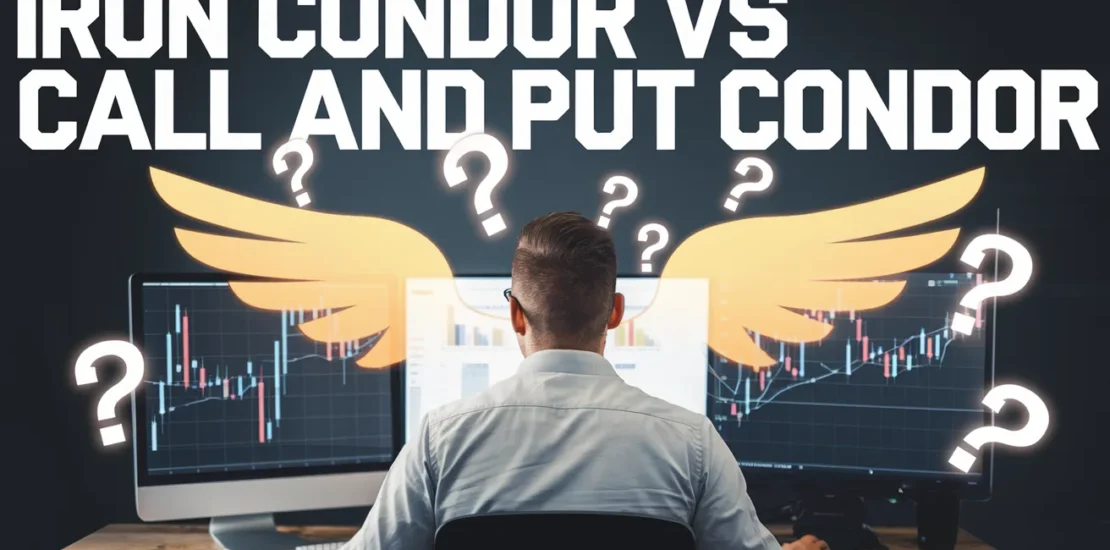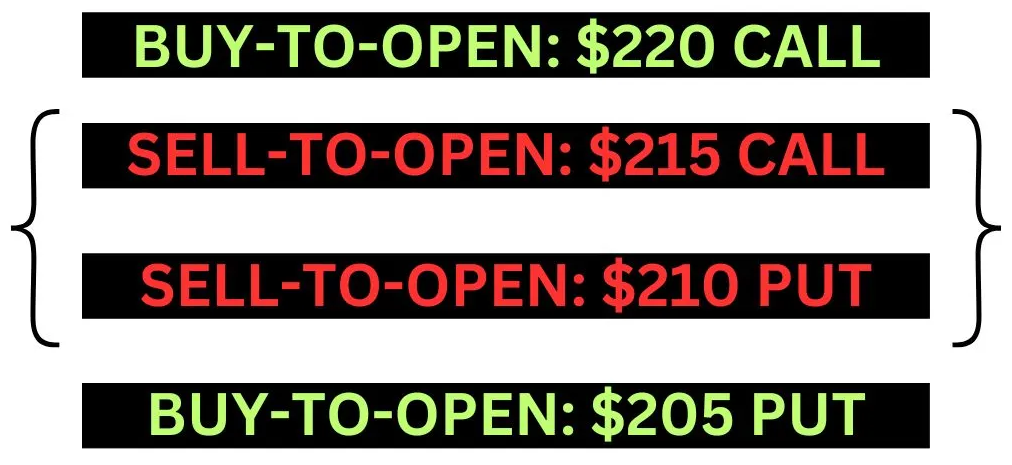- September 12, 2024
- Posted by: Jay Soloff
- Categories: Options Trading, Trading Article

Don’t be confused.
Options trading is filled with strategies designed to manage risk, hedge positions, or maximize potential profits. Sometimes different strategies have very similar objectives.
For example, two common strategies are the Iron Condor and the Call or Put Condor (also known as the Condor Spread).
While both strategies are structured using four different options contract. Both strategies are used when volatility is expected to be low…
These trades differ in how you execute them.
So, If you’re going to use either a Call or Put Condor, or an IRON Condor… keep reading
Click here to get “The Top 10 Stocks for Iron Condor Trades” – Free
Overview of the Condor Spread
Before diving into the nuances of each strategy, it’s important to understand the basics of the Condor Spread. Remember this is a neutral strategy that profits when the underlying asset stays within a defined price range.
There are two types of Condor Spreads: the Call Condor and the Put Condor.
Both use four different options contracts… but obviously, the Call Condor uses Call options… and the Put Condor uses Put options.
Here’s how they work:
Call Condor Spread
A Call Condor Spread involves using four different options contracts, each with a different strike price but sharing the same expiration date.
To set up a Call Condor, you first buy one call at a lower strike price. Then, sell two calls at middle strike prices, and finally, you buy another call at a higher strike price.
For example:

The goal of this strategy is for the price of the underlying asset to stay within the range of those middle strike prices at expiration. If the asset’s price remains within that range, you’ll make a profit.
The Put Condor Spread works the same way but uses put options instead of calls.
Put Condor Spread
You buy one put at a lower strike price, sell two puts at middle strike prices, and then buy one more put at a higher strike price.
Just like with the Call Condor, you need the underlying asset’s price to stay within the middle strike prices at expiration.
Both Call and Put Condors are defined-risk trades. So, you’ll know exactly how much you could potentially lose when you enter the trade.
The main difference is when you use them.
Call Condors vs Put Condors
| Strategy | Market Environment |
|---|---|
| Call Condors | Neutral to slightly bullish markets |
| Put Condors | Neutral to slightly bearish markets |
This makes them versatile strategies for traders with different market outlooks.
So, How do Put or Call Condor Spreads compare to an Iron Condor?
Let’s look at how an Iron Condor works…
Overview of the Iron Condor
The Iron Condor strategy uses both calls and puts. This strategy also involves four different options contracts with the same expiration date. The Iron Condor’s construction uses both a bull put spread and a bear call spread:
Here’s an example of how this trade might be positioned:

You profit the most when the underlying stock price is between the strike prices of the short call and short put. (So in our example – between $215 and $210).
In that example, the options expire worthless and you keep 100% of the premium collected.
Now you see why the Iron Condor is an excellent strategy in low-volatility environments.
So, what’s the big difference?
Differences Between an Iron Condor and a Call/Put Condor
At first glance, the Iron Condor and the Call/Put Condor may seem similar because they both involve four options contracts and aim to profit from minimal movement in the underlying asset.
However, several key distinctions set these strategies apart:
The main difference between these two strategies lies in the type of options used. The Iron Condor strategy uses both call and put options, creating a blend of two vertical spreads:
- bull put spread
- bear call spread
This combination allows for a more balanced approach, as it spreads the risk across both sides of the options market, giving traders more flexibility.
On the other hand, the Call or Put Condor uses either ALL call options or all put options—never a mix. As a result, risk is concentrated on one side of the market.
Iron Condor vs Call/Put Condor
| Strategy | Key Difference |
|---|---|
| Iron Condor | Uses both call and put options, creating a balanced approach with a blended risk profile across both sides of the options market. |
| Call/Put Condor | Uses only call options or only put options, concentrating the risk on one side of the market. |
In short, the Iron Condor offers a more balanced risk profile, as it spreads the exposure between both calls and puts.
The Call or Put Condor, however, concentrates the risk in one area, which can make it more susceptible to market movements on that side.
Risk And Profit Potential
When it comes to risk and profit potential, the Iron Condor’s profit is limited to the premiums collected from selling the options. The maximum risk is determined by the difference between the strike prices of the vertical spreads, minus the premium received.
Since the Iron Condor uses both calls and puts, you’ll always see one side or the other of the trade be profitable. It’s a more flexible strategy in many market conditions.
The Call or Put Condor also has a capped risk. It’s the difference between the strike prices of the options, minus the premium paid.
However, because this strategy uses only calls or puts, it generally has a narrower range of profitability.
In short, both strategies perform best in low-volatility markets, but the Iron Condor may offer a little more flexibility and room for error if volatility increases slightly compared to the Call/Put Condor.
Differences In Managing an Iron Condor and a Call/Put Condor
When it comes to adjustments and managing positions, the Iron Condor offers more flexibility.
Since the Iron Condor strategy uses both calls and puts, traders can tweak one side of the trade… without needing to touch the entire position.
This means you can adjust your strategy to respond to unexpected price movements while keeping part of the trade intact. That’s a big advantage when the market doesn’t behave as expected.
On the other hand, the Call/Put Condor is a bit trickier to manage.
Managing Call/Put Condor
Since it only uses one type of option. If the underlying asset moves beyond the middle strike prices, you may need to adjust the whole position.
This limits your ability to make partial changes, leaving fewer options for managing the trade if things start to go off course.
In terms of complexity, the Iron Condor is one of the more straightforward advanced options strategies, despite involving both calls and puts.
Its symmetrical structure makes it easy to monitor both sides of the trade, which simplifies things for traders.
Even intermediate traders can manage this strategy without too much trouble, as the balanced setup makes it more predictable and easier to track.
Strike Price Selection
The Call or Put Condor, while also simple in structure, requires more precision when it comes to choosing strike prices.
Because the profitability range is narrower, traders need to be more accurate in predicting how the market will behave.
This strategy is often better suited for traders who have a bit more experience with range-bound trading, as it demands more exact market forecasts.
Overall, both strategies are accessible for intermediate options traders, but the Iron Condor is an easier strategy to handle due to its wider range of potential profitability.
Full Comparison
| Aspect | Iron Condor | Call/Put Condor |
|---|---|---|
| Flexibility in Adjustments | More flexible; can adjust one side without affecting the entire position | Less flexible; adjustments often require modifying the entire position |
| Response to Price Movements | Can respond to unexpected price movements while keeping part of the trade intact | Limited ability to make partial changes |
| Complexity | More straightforward despite involving both calls and puts | Simpler in structure but requires more precision |
| Monitoring | Symmetrical structure makes it easy to monitor both sides of the trade | Requires more careful monitoring due to narrower profitability range |
| Suitability for Traders | Suitable for intermediate traders; easier to manage due to balanced setup | Better suited for more experienced traders, especially those familiar with range-bound trading |
| Strike Price Selection | More forgiving due to wider profitability range | Requires more precision; narrower profitability range |
| Market Forecast Accuracy | More tolerant of slight market forecast inaccuracies | Demands more exact market forecasts |
| Overall Manageability | Easier to handle due to wider range of potential profitability | Trickier to manage, especially if the underlying asset moves beyond middle strike prices |
Want to Learn More About Iron Condors?
If you’re interested in trading Iron Condors, keep in mind there are a million nuances to the strategy.
For example, reviewing the underlying stock, and developing a solid projection of its volatility can be critical.
Get this right, and you print money… get this wrong and you’ll see loss after loss.
I want to give you a leg up on Iron Condor trades. I’ve assembled a list of my 10 favorite stocks to trade Iron condors. It’s a great place to start if you’re looking for consistent income with limited risk.

